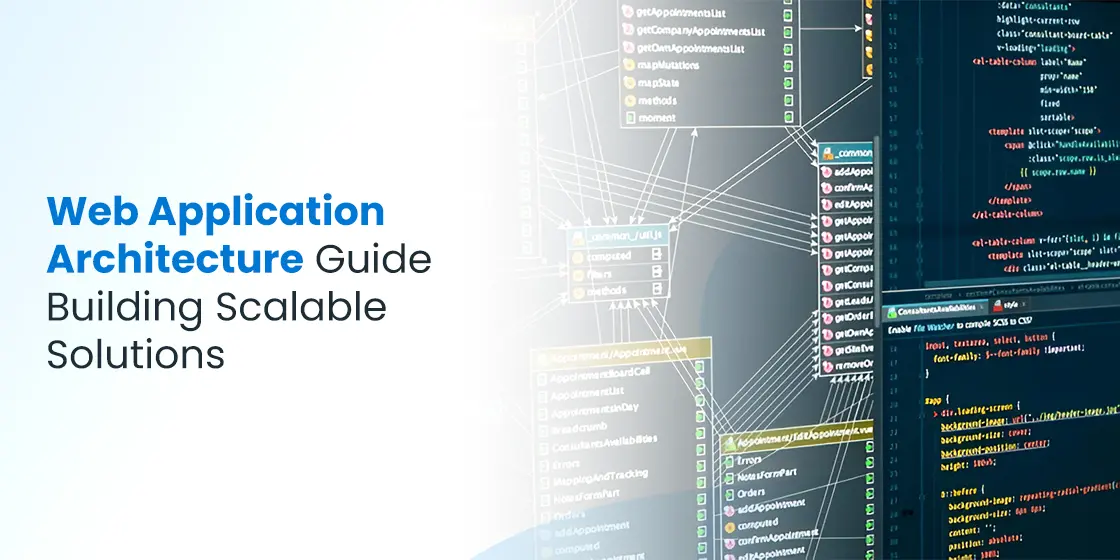Table of Content
Discover the Ins and Outs of Web Application Architecture Today
In today’s rapidly evolving digital landscape, web application architecture serves as the foundational blueprint that determines whether your application will succeed or struggle under real-world pressures. With over 83% of web applications still exhibiting at least one vulnerability and slow-loading websites contributing to annual revenue losses of $2.6 billion globally, understanding modern architectural principles has never been more critical.
The complexity of modern web applications demands sophisticated architectural approaches that balance performance, security, scalability, and maintainability. From AI-powered features to serverless computing, the architectural choices you make today will determine your application’s ability to adapt and thrive in an increasingly competitive digital ecosystem.
This comprehensive guide explores the essential components and best practices that define successful web application architecture in 2025. It provides web development services and business leaders with the insights needed to build robust, future-proof applications that can scale effortlessly and deliver exceptional user experiences.
Understanding Web Application Architecture Fundamentals

Web application architecture represents the structural framework that defines how different components of a web application interact, communicate, and collaborate to deliver functionality to end users. Unlike traditional software that runs on individual devices, web application architecture must orchestrate complex interactions between client-side interfaces, server-side logic, databases, and various middleware systems.
Defining Modern Web Architecture
At its core, web application architecture encompasses the arrangement of various components, modules, and technologies that work together to deliver the functionality of a web application. It determines how these components interact, how data flows within the application, and how the system handles user requests and responses. This architectural foundation influences everything from user experience and performance to security and scalability.
The Evolution of Web Applications
Modern web app development has evolved far beyond simple request-response cycles. Today’s applications must support real-time interactions, handle massive data volumes, integrate with multiple services, and provide seamless experiences across diverse devices and platforms. This evolution has driven the development of sophisticated architectural patterns that address these complex requirements while maintaining system reliability and performance.
Why Architecture Matters
A well-designed web application architecture ensures enhanced security, efficient development processes, seamless integration capabilities, and smooth user experiences while minimizing maintenance costs. According to industry research, poor architectural decisions can cost businesses between $9.7 and $14.2 million annually through data quality issues, security breaches, and performance problems.
Turn your concepts into mobile apps brimming with advanced features. From inception to deployment, make a distinct impact in the market.
Contact Now
Core Components of Web Application Architecture
Modern web application architecture consists of several interconnected components that work together to create a cohesive system capable of handling complex user interactions and business logic.
Client-Side Components
The client-side, or frontend, encompasses everything users see and interact with directly. This includes the user interface built with HTML for structure, CSS for styling, and JavaScript for interactivity. Modern frontend development has embraced frameworks like React, Angular, and Vue.js to create single-page applications (SPAs) that provide native app-like experiences within web browsers. These components handle user input validation, presentation logic, and initial data processing before communicating with server-side systems.
Server-Side Architecture
The server-side components form the backbone of web application architecture, handling business logic, data processing, and interactions with databases and external services. Web servers like Apache, Nginx, and Microsoft IIS manage incoming HTTP/HTTPS requests and route them appropriately. Application servers execute the core business logic, process user requests, and interact with databases or other services. This layer often utilizes programming languages like Python, Java, Node.js, Ruby, or PHP, depending on the specific requirements and technology stack.
Database and Storage Systems
The data layer provides persistent storage and retrieval capabilities for application information. This can include relational databases like PostgreSQL, MySQL, and Oracle for structured data, or NoSQL solutions like MongoDB, Cassandra, and Redis for handling large volumes of unstructured or semi-structured data. Modern applications increasingly leverage cloud storage solutions like Amazon S3, which offer scalable, secure, and cost-effective options with pay-as-you-go models that align storage costs with actual usage.
Architectural Layers and Their Functions

Web application architecture typically organizes functionality into distinct layers that promote separation of concerns, improve maintainability, and enable independent scaling of different system components.
Presentation Layer
The presentation layer, also known as the client tier, handles all user-facing elements and interactions. This layer manages the user interface, user experience design, input validation, and client-side processing. Modern presentation layers increasingly implement responsive design principles to ensure consistent experiences across desktop, tablet, and mobile devices. Progressive Web Applications (PWAs) represent an evolution of this layer, combining web technologies with native app capabilities like offline functionality and push notifications.
Business Logic Layer
The business logic layer, or application tier, contains the core functionality that defines how the application processes requests, enforces business rules, and coordinates between different system components. This layer handles authentication, authorization, data validation, workflow management, and integration with external services. It serves as the intermediary between the presentation layer and the data access layer, ensuring that business rules are consistently applied across all user interactions.
Data Access Layer
The data access layer manages all interactions with persistent storage systems, including databases, file systems, and external data sources. This layer abstracts the complexities of data storage and retrieval, providing consistent interfaces for the business logic layer to access information. It handles database connections, query optimization, caching strategies, and data transformation between different formats. Modern data access layers often implement techniques like connection pooling, lazy loading, and distributed caching to optimize performance.
Elevate your online presence with websites that blend visual appeal with advanced functionalities. Explore our tailored web development solutions today.
Discover Web SolutionsTypes of Web Application Architecture Patterns
Different architectural patterns address varying requirements for scalability, complexity, and organizational needs, each offering distinct advantages and trade-offs.
Monolithic Architecture
Monolithic architecture integrates all application components into a single, unified codebase and deployment unit. This approach offers simplicity in development, testing, and deployment, making it ideal for smaller applications or teams just starting their development journey. All components communicate through internal method calls rather than network requests, resulting in better performance for smaller applications. However, monolithic architectures can become challenging to maintain and scale as applications grow, since any changes require redeploying the entire system.
Microservices Architecture
Microservices architecture breaks applications into smaller, independent services that communicate through well-defined APIs. Each microservice handles a specific business function and can be developed, deployed, and scaled independently. This pattern enables organizations to use different technologies for different services, allows teams to work independently, and provides better fault isolation. Companies like Netflix, Amazon, and Uber have successfully implemented microservices in enterprise website development to handle massive scale and complexity while maintaining system reliability.
Serverless Architecture
Serverless architecture allows developers to focus on writing code without managing underlying infrastructure. In this model, cloud providers handle server provisioning, scaling, and maintenance automatically. Applications are built using small, stateless functions that execute in response to specific events. This approach offers automatic scaling, reduced operational costs, and faster development cycles. Serverless platforms like AWS Lambda, Azure Functions, and Google Cloud Functions charge only for actual execution time, making this pattern cost-effective for applications with variable traffic patterns.
Modern Architectural Trends Shaping 2025
The landscape of web application architecture continues evolving rapidly, driven by emerging technologies and changing user expectations.
AI and Machine Learning Integration
Artificial intelligence and machine learning are becoming integral components of modern web application architecture. AI-powered features like personalization engines, intelligent chatbots, and automated content generation require architectural considerations for model deployment, data processing, and real-time inference. Edge AI processing enables applications to run machine learning models closer to users, reducing latency and improving privacy. Development tools like GitHub Copilot are automating repetitive coding tasks, while platforms like GPT-4 generate dynamic content and streamline workflows.
Edge Computing and CDN Evolution
Edge computing represents a fundamental shift toward distributed architectures that process data closer to users. Content Delivery Networks (CDNs) have evolved beyond simple static content distribution to support dynamic content processing, serverless function execution, and real-time data analysis at edge locations. This trend reduces latency, improves user experience, and enables applications to provide faster responses regardless of user location.
Progressive Web Applications and JAMstack
Progressive Web Applications continue gaining traction by combining web technologies with native app capabilities like offline functionality, push notifications, and device integration. JAMstack (JavaScript, APIs, and Markup) architecture emphasizes pre-rendered static content delivered through CDNs, resulting in faster load times, improved security, and better developer experience. Major brands report significant performance improvements and increased user engagement when implementing these architectural patterns.
Client-Server Architecture Models

Understanding different client-server models helps architects choose appropriate patterns based on application requirements and user expectations.
Traditional Client-Server Model
The traditional client-server model divides functionality between client applications that request services and servers that provide resources and processing capabilities. This two-tier architecture enables centralized data management, easier maintenance, and better security control. However, it can create bottlenecks when server resources become overwhelmed by client requests, and network latency can impact user experience.
Three-Tier Architecture
Three-tier architecture introduces a middle layer between clients and databases, separating presentation logic, business logic, and data storage into distinct tiers. This separation improves scalability by allowing each tier to be optimized and scaled independently. The presentation tier handles user interfaces, the business tier processes application logic, and the data tier manages information storage and retrieval. This pattern provides better security by preventing direct client access to databases and enables more flexible technology choices for each tier.
Multi-Tier and N-Tier Systems
Multi-tier architectures extend the three-tier model by introducing additional layers for specific functions like caching, message queuing, integration services, and security enforcement. These architectures provide greater flexibility and scalability but require more complex management and monitoring. Modern applications often implement hybrid approaches that combine multiple architectural patterns to address specific requirements for different system components.
Security Considerations in Web Architecture
Security must be integrated into every layer of web application architecture rather than treated as an afterthought. Some of the most common security considerations include:
- Authentication and authorization
- Data protection and encryption
- Application security best practices
Best Practices for Architecture Implementation
Successful web application architecture implementation requires adherence to established best practices and tips, which includes the likes of choosing between SPA vs MPA framework. Some of the best practices that ensure successful architecture implementation include:
- Design for modularity and separation of concerns
- Implement continuous integration and deployment
- Plan for disaster recovery and business continuity
Frequently Asked Questions (FAQs)
| What is the difference between monolithic and microservices web application architecture? Monolithic architecture builds all application components into a single, unified codebase and deployment unit, making it simpler to develop and deploy initially but harder to scale and maintain as the application grows. Microservices architecture breaks the application into smaller, independent services that communicate through APIs, enabling independent scaling, technology diversity, and team autonomy. While monolithic architecture works well for smaller applications, microservices provide better flexibility and scalability for complex, large-scale systems that require independent component updates and scaling. |
| How do I choose the right database for my web application architecture? Database selection depends on your specific data requirements, scalability needs, and consistency requirements. Relational databases like PostgreSQL and MySQL work well for structured data with complex relationships and ACID compliance needs. NoSQL databases like MongoDB handle unstructured data and horizontal scaling better. Key-value stores like Redis excel at caching and session management. Many modern applications use polyglot persistence, combining multiple database types to optimize performance for different data access patterns and use cases. |
| What are the essential security considerations for web application architecture? Essential security considerations include implementing multi-factor authentication and role-based access controls, encrypting data both in transit (using TLS/SSL) and at rest, following OWASP Top 10 guidelines to prevent common vulnerabilities, implementing proper input validation and output encoding, using security headers and HTTPS everywhere, and integrating security testing throughout the development lifecycle. Zero-trust architecture principles assume all interactions must be verified, while compliance requirements like GDPR and HIPAA may impose additional data protection obligations. |
| How can I ensure my web application architecture scales effectively? Effective scaling requires designing for horizontal scaling (adding more servers) rather than just vertical scaling (upgrading hardware), implementing caching strategies at multiple levels (browser, application, database), using load balancers to distribute traffic across multiple servers, and designing stateless applications that don’t store user data between sessions. Microservices architecture enables independent scaling of different components, while cloud platforms provide auto-scaling capabilities. Monitoring and performance testing help identify bottlenecks before they impact users. |
| What role does cloud infrastructure play in modern web application architecture? Cloud infrastructure provides scalable, managed services that reduce operational complexity and enable rapid scaling. Infrastructure as a Service (IaaS) offers flexible virtual computing resources, Platform as a Service (PaaS) provides integrated development and deployment environments, and Software as a Service (SaaS) delivers ready-to-use applications. Cloud platforms enable auto-scaling, global content distribution through CDNs, managed databases, and serverless computing options. Container orchestration platforms like Kubernetes facilitate consistent deployment across different environments while providing automatic scaling and service management. |
Conclusion
Web application architecture serves as the foundation for building successful, scalable, and maintainable applications in today’s complex digital landscape. As we advance through 2025, the integration of artificial intelligence, edge computing, serverless technologies, and advanced security measures continues reshaping how we design and implement web applications.
The key to successful web application architecture lies in understanding that it’s not a one-size-fits-all solution. Each application has unique requirements for scalability, performance, security, and functionality that must be carefully considered when making architectural decisions. Whether implementing a monolithic architecture for a simple application or designing a complex microservices ecosystem for enterprise-scale systems, the principles of modularity, security, and performance optimization remain fundamental.
Empower your digital initiatives with BariTechSol, a premier custom software development company. Our skilled team tailors cutting-edge solutions to your unique needs. Elevate your tech experience and stay ahead in the digital realm. Partner with BaritechSol and code the success of your next big idea.


